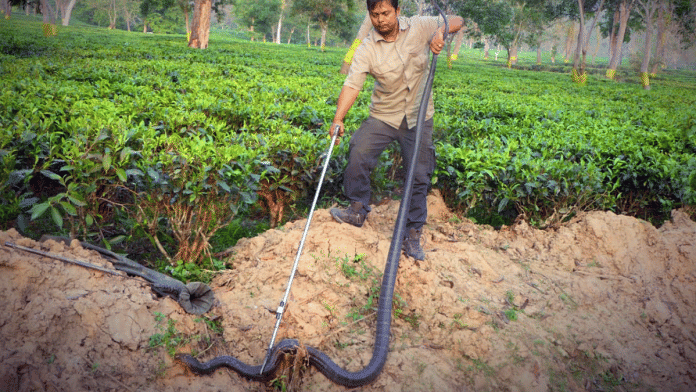New Delhi: India is the world’s worst-affected country by snake bites, with one study estimating that 51,100 people died in 2019. Now, a new paper has found the financial burden of snake bites in Madhya Pradesh: Rs 231.16 crore in just two years was disbursed from the exchequer as compensation to families of such victims.
Published on 6 August in the Transactions of The Royal Society of Tropical Medicine and Hygiene journal, the study is the first of its kind to use government records of snakebite deaths and compensation in Madhya Pradesh.
Led by Dr. Priyanka Kadam, founder of the Snakebite Healing and Education Society, the study found that there were a total of 5,779 recorded snakebite deaths in Madhya Pradesh between 2020 and 2022. The compensation provided by the Madhya Pradesh government is Rs 4 lakh per death for each “successful snakebite claim.”
Using this data, the authors created a heat map of district-wide snakebite deaths in MP and found that Sagar and Satna districts had the highest deaths. Burhanpur and Bhopal, on the other hand, had the lowest mortality.
“We’re lucky to be blessed with a rich biodiversity in India, but we also have high population density. Given that most 70 percent of our country lives in rural regions, with poor houses where it is so easy for rats and snakes to enter — the chances of snake bites are just higher,” Dr. Priyanka Kadam told The Print.
To understand how the incident occurred, what was the healthcare provided to victims, and what was the process of compensation, the study conducted qualitative interviews with 15 families that received compensation from the government. They found that almost half of the snakebites in the group occurred when the victim was asleep, while the rest was either when the victim was working or cooking.
Highest global mortality rate
A 2022 Nature Communications study estimated that out of 63,400 snakebite deaths globally in 2019, 51,100 were in India alone. Snake bites are part of the World Health Organisation’s neglected tropical diseases (NTD) list, and it plans to reduce snakebite mortality by 50 percent by 2030.
However, several factors currently affect the high snakebite mortality rate in India. According to Kadam, only 17 out of the 300 or so snake species in India are medically important based on the reported deaths. And only four venomous species — Russell viper, common krait, Indian spectacled cobra, and Indian saw-scaled viper — report maximum deaths as they are are found in areas close to human habitats.
“The issue isn’t just the presence of snakes, it’s also the population density. Africa probably has many more venomous varieties than India, but their death rates aren’t as high because it is a sparsely populated region,” explains Kadam.
In their study, the researchers calculated the death by snake bite numbers against the population in each district. In places like Satna and Sagar, there were 6.2 deaths by snakebites for every 1,00,000 people.
Another important factor that Kadam pointed out was the availability of first aid and access to proper healthcare.
Eleven out of the 15 snakebite cases interviewed said they first “undertook a form of traditional healing” before accessing official healthcare. Six cases faced delays in getting to the hospital or the primary healthcare unit, and seven were asked to go to a higher hospital.
The interviews also showed 11 of the 15 victims were women, and were either asleep on the floor or working in agriculture — both of which are consistent with being “well-known snakebite risk factors.”
The study did admit its limitations: the qualitative survey was only of 15 families and conducted in one district. Also, the data collection of both snakebite deaths and compensation came only from official sources. The researchers spoke about the possibility of many unregistered snakebite victims, and also compensation claims that are denied by the government.
However, it was the first ever such study that analysed both the mortality and financial aspects of the snakebite deaths problem in India, according to Kadam. Along with the compensation though, the study urges structural and policy changes to identify the causes of snakebite mortalities and act on them – including access to appropriate snake bite first aid and other broader interventions.
This is an updated version of the report with compensation figure in Rs crore.
(Edited by Tony Rai)
Also Read: Landslides hit Wayanad, left it ‘completely isolated’ during Kerala’s Great Flood 100 years ago






